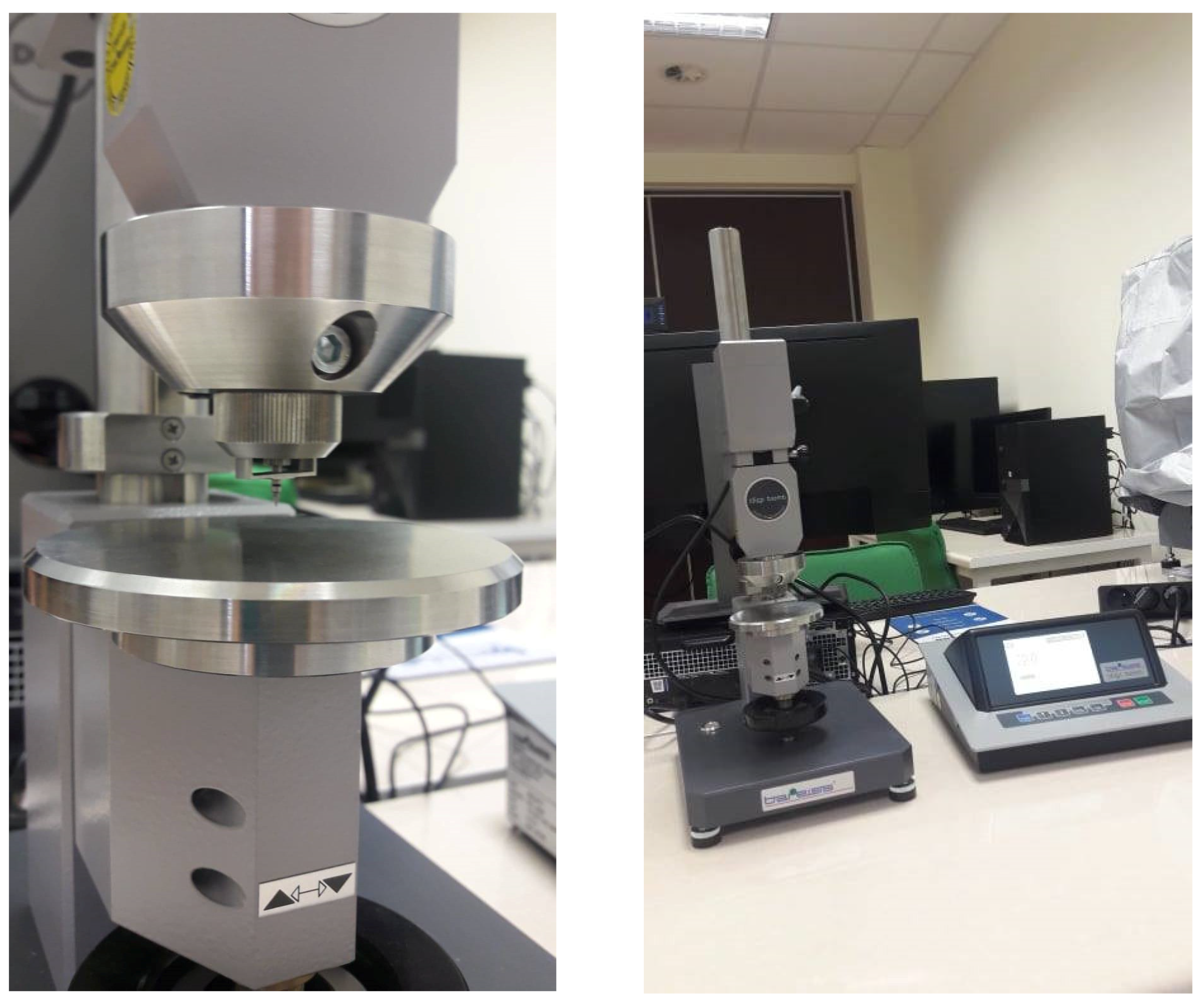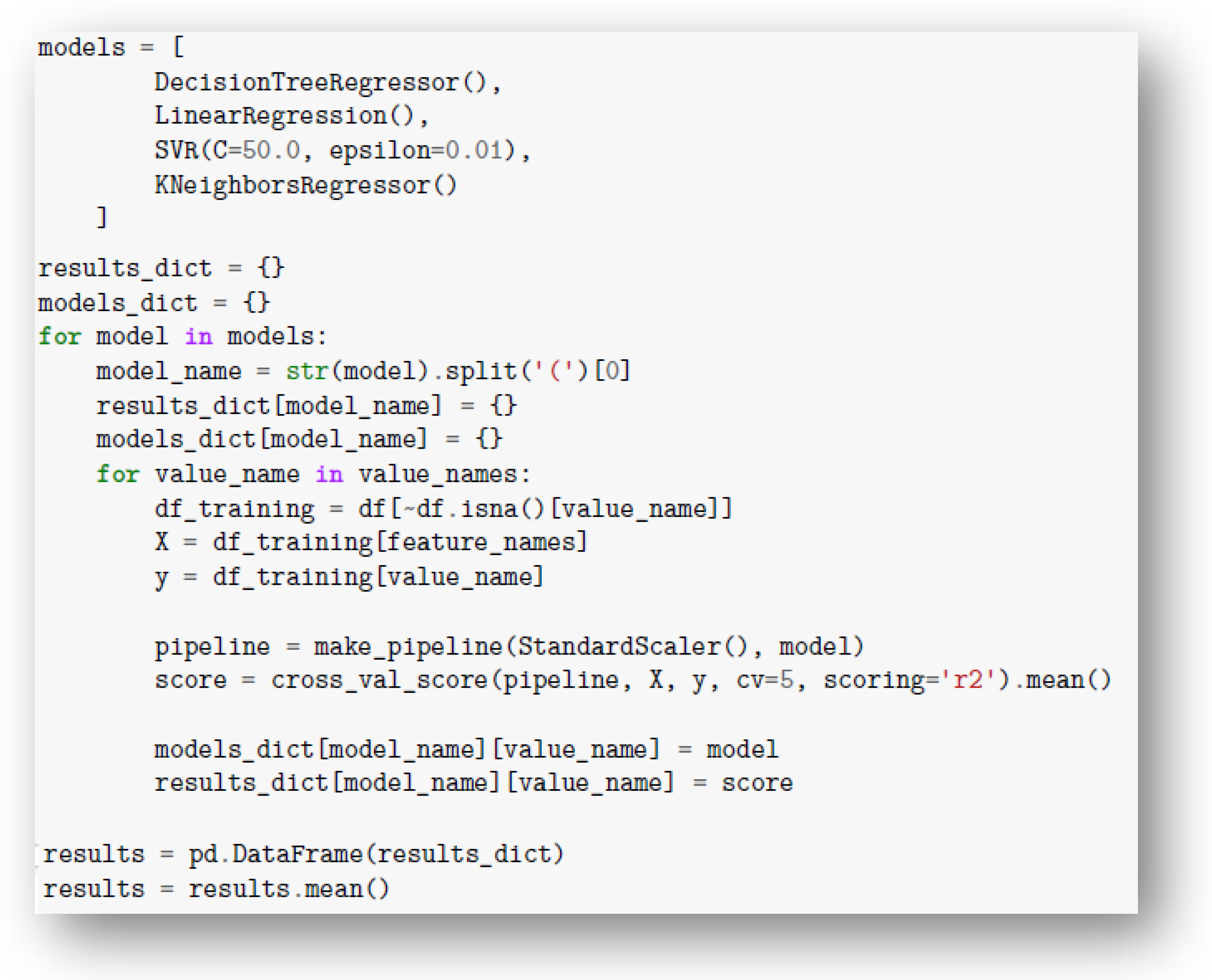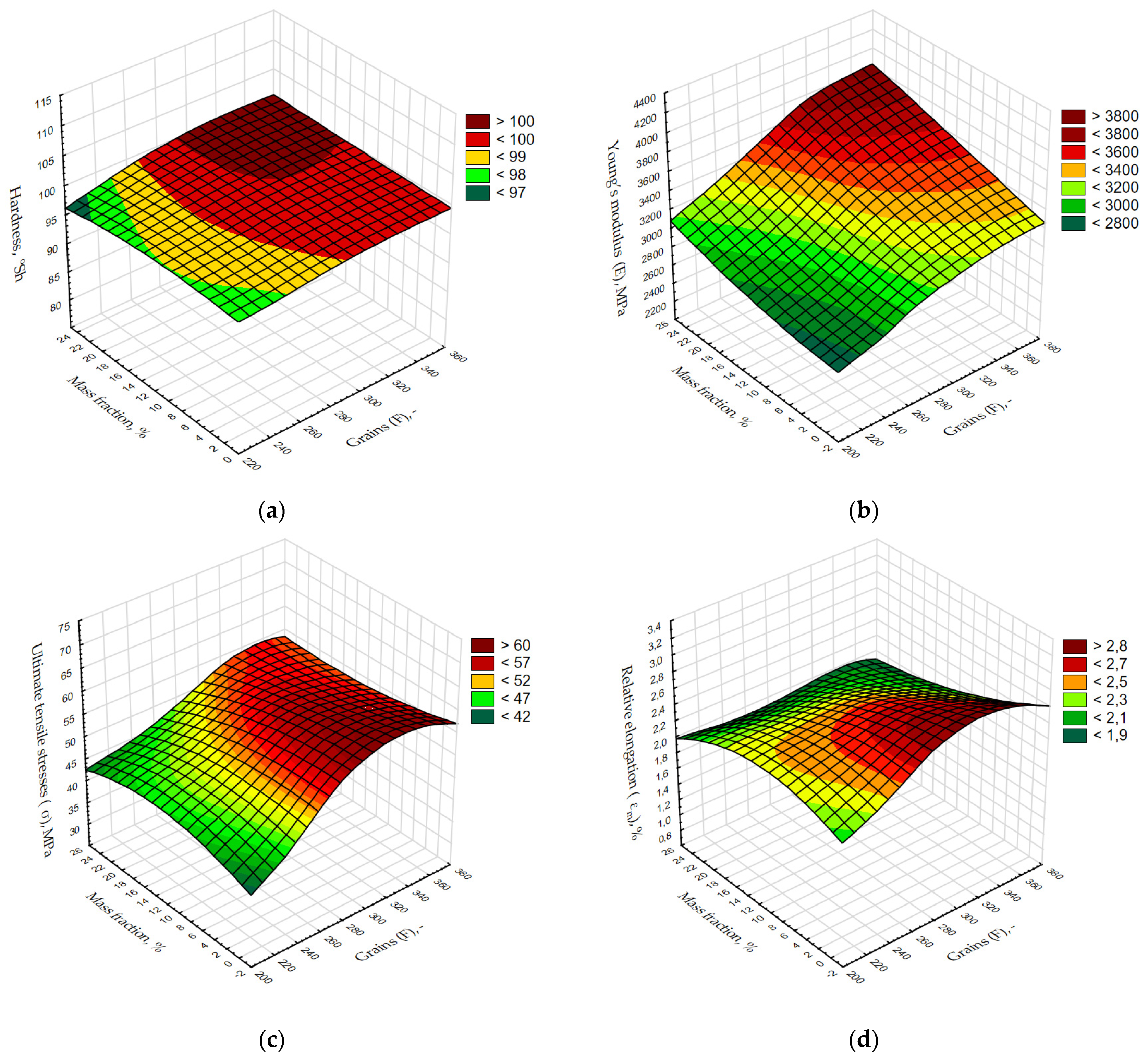Prediction of Selected Mechanical Properties of Polymer Composites with Alumina Modifiers
Abstract
:1. Introduction
The Role of AI in Engineering Issues
2. Materials and Method
3. Results Discussion
- Activation=‘logistic’;
- Hidden_layer_sizes;
- Learning_rate=‘adaptive’;
- Solver=‘Ibfgs’.
4. Conclusions
Author Contributions
Funding
Institutional Review Board Statement
Data Availability Statement
Conflicts of Interest
References
- Kosicka, E.; Gola, A.; Pawlak, J. Application-based support of machine maintenance. IFAC-PapersOnLine 2019, 52, 131–135. [Google Scholar] [CrossRef]
- Ojokoh, B.A.; Samuel, O.W.; Omisore, O.M.; Sarumi, O.A.; Idowu, P.A.; Chimusa, E.R.; Darwish, A.; Adekoya, A.F.; Katsriku, F.A. Big data, analytics and artificial intelligence for sustainability. Sci. Afr. 2020, 9, e00551. [Google Scholar] [CrossRef]
- Žigienė, G.; Rybakovas, E.; Alzbutas, R. Artificial Intelligence Based Commercial Risk Management Framework for SMEs. Sustainability 2019, 11, 4501. [Google Scholar] [CrossRef] [Green Version]
- Hegde, J.; Rokseth, B. Applications of machine learning methods for engineering risk assessment—A review. Saf. Sci. 2020, 122, 104492. [Google Scholar] [CrossRef]
- Mrówka, M.; Woźniak, A.; Nowak, J.; Wróbel, G.; Sławski, S. Determination of Mechanical and Tribological Properties of Silicone-Based Composites Filled with Manganese Waste. Materials 2021, 14, 4459. [Google Scholar] [CrossRef]
- Warminski, J.; Kloda, L.; Latalski, J.; Mitura, A.; Kowalczuk, M. Nonlinear vibrations and time delay control of an extensible slowly rotating beam. Nonlinear Dyn. 2021, 103, 3255–3281. [Google Scholar] [CrossRef]
- Domińczuk, J. Prediction of adhesive joints strength based on the modified de bruyn method using the numerical methods. Technol. Autom. Montażu 2019, 3, 37–41. [Google Scholar]
- Antosz, K.; Pasko, L.; Gola, A. The Use of Intelligent Systems to Support the Decision-Making Process in Lean Maintenance Management. IFAC-PapersOnLine 2019, 52, 148–153. [Google Scholar] [CrossRef]
- Sobaszek, Ł.; Gola, A.; Świć, A. Time-based machine failure prediction in multi-machine manufacturing systems. Eksploat. Niezawodn. 2020, 22, 52–62. [Google Scholar] [CrossRef]
- Sobotka, A. Innovative solutions in engineering of construction projects. Procedia Eng. 2007, 208, 160–165. [Google Scholar] [CrossRef]
- Dziallas, M.; Blind, K. Innovation indicators throughout the innovation process: An extensive literature analysis. Technovation 2019, 80–81, 3–29. [Google Scholar] [CrossRef]
- Singer, G.; Cohen, Y. A framework for smart control using machine-learning modeling for processes with closed-loop control in Industry 4.0. Eng. Appl. Artif. Intell. 2021, 102, 104236. [Google Scholar] [CrossRef]
- Rymarczyk, T.; Przysucha, B.; Kowalski, M.; Bednarczuk, P. Analysis of Data from Measuring Sensors for Prediction in Production Process Control Systems. Inform. Autom. Pomiary Gospod. Ochr. Sr. 2019, 9, 26–29. [Google Scholar] [CrossRef]
- Michałowska, J.; Józwik, J. Prediction of the parameters of magnetic field of CNC machine tools. Prz. Elektrotechniczny 2019, 95, 134–136. [Google Scholar] [CrossRef] [Green Version]
- Pater, Z.; Tomczak, J.; Bulzak, T.; Bartnicki, J.; Tofil, A. Prediction of Crack Formation for Cross Wedge Rolling of Harrow Tooth Preform. Materials 2019, 12, 2287. [Google Scholar] [CrossRef] [PubMed] [Green Version]
- Kulisz, M.; Zagórski, I.; Korpysa, J. Surface quality simulation with statistical analysis after milling AZ91D magnesium alloy using PCD tool. J. Phys: Conf. Ser. 2021, 1736, 012034. [Google Scholar] [CrossRef]
- Kulisz, M.; Zagórski, I.; Weremczuk, A.; Rusinek, R.; Korpysa, J. Analysis and prediction of the impact of technological parameters on cutting force components in rough milling of AZ31 magnesium alloy. Arch. Civ. Mech. Eng. 2022, 22, 1. [Google Scholar] [CrossRef]
- Chen, C.; Gu, G. Machine learning for composite materials. MRS Commun. 2019, 9, 556–566. [Google Scholar] [CrossRef] [Green Version]
- Samborski, S. Prediction of delamination front’s advancement direction in the CFRP laminates with mechanical couplings subjected to different fracture toughness tests. Compos. Struct. 2018, 202, 643–650. [Google Scholar] [CrossRef]
- Machrowska, A.; Szabelski, J.; Karpiński, R.; Krakowski, P.; Jonak, J.; Jonak, K. Use of Deep Learning Networks and Statistical Modeling to Predict Changes in Mechanical Parameters of Contaminated Bone Cements. Materials 2020, 13, 5419. [Google Scholar] [CrossRef]
- Pan, Y.; Zhang, L. Roles of artificial intelligence in construction engineering and management: A critical review and future trends. Autom. Constr. 2021, 122, 103517. [Google Scholar] [CrossRef]
- Kłosowski, G.; Gola, A.; Amila, T. Computational Intelligence in Control of AGV Multimodal Systems. IFAC-PapersOnLine 2018, 51, 1421–1427. [Google Scholar] [CrossRef]
- Yang, L.B. Application of Artificial Intelligence in Electrical Automation Control. Procedia Comput. Sci. 2020, 166, 292–295. [Google Scholar] [CrossRef]
- Mejri, M.; Bekara, M. Application of Machine Learning for the Automation of the Quality Control of Noise Filtering Processes in Seismic Data Imaging. Geosciences 2020, 10, 475. [Google Scholar] [CrossRef]
- Ye, S.; Li, B.; Li, Q.; Zhao, H.-P.; Feng, X.-Q. Deep neural network method for predicting the mechanical properties of composites. Appl. Phys. Lett. 2019, 115, 161901. [Google Scholar] [CrossRef]
- Chen, Q.; Ji, R.; Pang, S. Deep long short-term memory neural network for accelerated elastoplastic analysis of heterogeneous materials: An integrated data-driven surrogate approach. Compos. Struct. 2021, 264, 113688. [Google Scholar] [CrossRef]
- Zhu, P.; Zhou, S.; Zhen, J.; Li, Y. Application of Artificial Neural Network in Composite Research. In Advances in Swarm Intelligence; Lecture Notes in Computer Science; Tan, Y., Shi, Y., Tan, K.C., Eds.; Springer: Berlin/Heidelberg, Germany, 2010; Volume 6146. [Google Scholar] [CrossRef]
- Seyhan, A.; Tayfur, G.; Karakurt, M.; Tanoğlu, M. Artificial neural network (ANN) prediction of compressive strength of vartm processed polymer composites. Comput. Mater. Sci. 2005, 34, 99–105. [Google Scholar] [CrossRef] [Green Version]
- Kumar, P.; Vengal, K.; Kundavarapu, R.; Ravishankar, V.; Venkata, D.; Kaki, R. Modeling of glass fiber reinforced composites for optimal mechanical properties using teaching learning-based optimization and artificial neural networks. SN Appl. Sci. 2020, 2, 131. [Google Scholar] [CrossRef] [Green Version]
- El Kadi, H.A.; Al-Assaf, Y. The Use of Neural Networks in the Prediction of the Fatigue Life of Different Composite Materials. In Proceedings of the 16th International Conference on Composite Materials, Kyoto, Japan, 8–13 July 2007; pp. 1–9. [Google Scholar] [CrossRef]
- Al-Assadi, M.; El Kadi, H.; Deiab, I.M. Predicting the Fatigue Life of Different Composite Materials Using Artificial Neural Networks. Appl. Compos. Mater. 2010, 17, 1–14. [Google Scholar] [CrossRef]
- Mini, M.K.; Sowmya, M. Neural network paradigms for fatigue strength prediction of fiber-reinforced composite materials. Int, J. Adv. Struct. Eng. 2012, 4, 7. [Google Scholar] [CrossRef] [Green Version]
- Suresh, A.; Harsha, A.P.; Ghosh, M.K. Erosion studies of short glass fiber-reinforced thermoplastic composites and prediction of erosion rate using ANNs. J. Reinf. Plast. Compos. 2010, 29, 1641–1652. [Google Scholar] [CrossRef]
- Jiang, Z.; Gyurova, L.; Zhang, Z.; Friedrich, K.; Schlarb, A.K. Neural network based prediction on mechanical and wear properties of short fibers reinforced polyamide composites. Mater. Des. 2008, 29, 628–637. [Google Scholar] [CrossRef]
- FEPA 42-2:2006; Microgrits F230~F2000 Specifications. FEPA Standard: Courbevoie, France, 2006.
- ISO 527-2:2012; Plastics—Determination of Tensile Properties—Part 2: Test Conditions for Moulding and Extrusion Plastics. International Organization for Standardization: Geneva, Switzerland, 2012.
- ISO 868:2003; Plastics and Ebonite—Determination of Indentation Hardness by Means of a Durometer (Shore hardness). International Organization for Standardization: Geneva, Switzerland, 2003.
- McKinney, W. Python w Analizie Danych; Helion: Gliwice, Poland, 2018; ISBN 9788328340817. [Google Scholar]
- Aggrawal, H.O.; Modersitzki, J. Hessian Initialization Strategies for L-BFGS Solving Non-Linear Inverse Problems. In Scale Space and Variational Methods in Computer Vision; Springer: Wiesbaden, Germany, 2021; pp. 216–228. [Google Scholar]
- Nazarko, J. Prognozowanie w Zarządzaniu Przedsiębiorstwem, cz. IV Prognozowanie na Podstawie Modeli Trendu; Oficyna W Oficyna Wydawnicza Politechniki Bialostockiej: Bialystok, Poland, 2018; ISBN 978-83-65596-33-8. [Google Scholar]
- Mrówka, M.; Szymiczek, M.; Machoczek, T.; Lenża, J.; Matusik, J.; Sakiewicz, P.; Skonieczna, M. The influence of halloysite on the physicochemical, mechanical and biological properties of polyurethane based nanocomposites. Polimery 2020, 65, 784–791. [Google Scholar] [CrossRef]
- Mrówka, M.; Szymiczek, M.; Machoczek, T.; Pawlyta, M. Influence of the Halloysite Nanotube (HNT) Addition on Selected Mechanical and Biological Properties of Thermoplastic Polyurethane. Materials 2021, 14, 3625. [Google Scholar] [CrossRef] [PubMed]
- Sarraj, S.; Szymiczek, M.; Machoczek, T.; Mrówka, M. Evaluation of the Impact of Organic Fillers on Selected Properties of Organosilicon Polymer. Polymers 2021, 13, 1103. [Google Scholar] [CrossRef] [PubMed]
- Mrówka, M.; Woźniak, A.; Prężyna, S.; Sławski, S. The Influence of Zinc Waste Filler on the Tribological and Mechanical Properties of Silicone-Based Composites. Polymers 2021, 13, 585. [Google Scholar] [CrossRef]
- Sławski, S.; Szymiczek, M.; Kaczmarczyk, J.; Domin, J.; Świtoński, E. Low Velocity Impact Response and Tensile Strength of Epoxy Composites with Different Reinforcing Materials. Materials 2020, 13, 3059. [Google Scholar] [CrossRef]






| Mse Values For Individual Data Sets | ||||
|---|---|---|---|---|
| Model | Hardness | Et | σm | εm |
| Decision Tree Regressor | 1.5596 | 6057.3994 | 26.0022 | 0.1032 |
| MLP Regressor | 1.4614 | 6259.9139 | 25.2744 | 0.1060 |
| Linear Regression | 1.4810 | 10761.3150 | 50.4864 | 0.1851 |
| SVR | 1.4686 | 25829.4423 | 48.8113 | 0.1326 |
| K-Neighbors Regressor | 1.5443 | 7146.3127 | 31.3305 | 0.1198 |
| Activation | Alpha | Hidden Layer Sizes | R2 Score | |
|---|---|---|---|---|
| 0 | logistic | 0.0001 | 23 | 0.329345321 |
| 1 | logistic | 0.0001 | 25 | 0.316109079 |
| 2 | logistic | 0.0001 | 19 | 0.313990104 |
| 3 | logistic | 0.001 | 25 | 0.312857918 |
| 4 | logistic | 0.0001 | 21 | 0.293111995 |
| 5 | logistic | 0.001 | 21 | 0.285338460 |
| 6 | logistic | 0.0001 | 17 | 0.269040464 |
| 7 | logistic | 0.001 | 19 | 0.263106927 |
| 8 | logistic | 0.001 | 23 | 0.242614750 |
| 9 | identity | 0.0001 | 23 | 0.229048600 |
| 10 | identity | 0.0001 | 13 | 0.226608287 |
| 11 | identity | 0.0001 | 9 | 0.225083033 |
| 12 | logistic | 0.001 | 17 | 0.223577093 |
| 13 | identity | 0.001 | 7 | 0.218035216 |
| 14 | identity | 0.001 | 5 | 0.212440871 |
| 15 | identity | 0.0001 | 25 | 0.203615714 |
| 16 | identity | 0.001 | 17 | 0.202399900 |
| 17 | identity | 0.001 | 19 | 0.198601455 |
| 18 | identity | 0.0001 | 17 | 0.196738083 |
| 19 | identity | 0.0001 | 5 | 0.196004000 |
| 20 | identity | 0.0001 | 7 | 0.188281408 |
| Et | σm | εm | Hardness | |||||
|---|---|---|---|---|---|---|---|---|
| Composition of The Composite | ME | MPE [%] | ME | MPE [%] | ME | MPE [%] | ME | MPE [%] |
| EA 220/5 | 13.93 | 0.60% | 1.97 | 4.09% | 0.11 | 4.90% | −0.55 | −0.68% |
| EA 220/10 | 41.40 | 1.84% | 3.46 | 6.84% | 0.16 | 6.63% | 0.33 | 0.39% |
| EA 220/15 | −11.82 | −0.49% | −1.37 | −3.20% | −0.08 | −4.10% | −1.88 | −2.32% |
| EA 220/20 | −8.40 | −0.32% | 2.08 | 4.46% | 0.26 | 12.29% | −0.36 | −0.45% |
| EA 220/25 | −23.13 | −0.84% | 0.19 | 0.40% | −0.01 | −0.40% | 0.28 | 0.34% |
| EA 240/5 | −21.78 | −0.91% | 0.90 | 1.52% | 0.21 | 7.73% | 1.18 | 1.43% |
| EA 240/10 | 9.72 | 0.39% | 2.81 | 4.82% | 0.16 | 5.82% | −0.10 | −0.12% |
| EA 240/15 | 21.17 | 0.83% | 2.56 | 4.78% | 0.16 | 6.46% | 0.03 | 0.03% |
| EA 240/20 | −8.19 | −0.31% | 3.17 | 6.31% | 0.17 | 8.23% | 0.52 | 0.62% |
| EA 240/25 | −37.17 | −1.44% | −2.27 | −5.92% | −0.03 | −2.05% | −0.05 | −0.06% |
| EA 280/5 | 33.63 | 1.34% | −1.12 | −2.29% | −0.14 | −7.04% | −0.68 | −0.83% |
| EA 280/10 | −92.36 | −3.88% | −1.82 | −3.65% | −0.05 | −2.15% | −0.13 | −0.15% |
| EA 280/15 | 38.43 | 1.53% | −3.05 | −6.28% | −0.26 | −12.56% | −0.20 | −0.24% |
| EA 280/20 | 24.49 | 0.97% | 0.72 | 1.70% | 0.03 | 1.95% | 0.19 | 0.23% |
| EA 280/25 | −1.65 | −0.06% | −2.29 | −5.63% | −0.08 | −5.24% | −0.12 | −0.15% |
| EA 320/5 | −14.67 | −0.63% | 2.11 | 3.98% | 0.11 | 4.62% | 0.69 | 0.82% |
| EA 320/10 | −12.92 | −0.52% | −0.04 | −0.07% | 0.00 | −0.05% | 0.25 | 0.29% |
| EA 320/15 | 2.56 | 0.10% | −1.48 | −2.62% | −0.15 | −6.46% | −0.19 | −0.22% |
| EA 320/20 | −47.68 | −1.83% | −2.42 | −4.33% | −0.15 | −6.36% | 0.09 | 0.11% |
| EA 320/25 | −21.90 | −0.84% | −2.30 | −6.23% | −0.07 | −5.18% | 0.20 | 0.24% |
| EA 360/5 | 9.27 | 0.40% | −3.91 | −8.40% | −0.20 | −9.15% | 0.74 | 0.89% |
| EA 360/10 | 0.99 | 0.04% | 1.94 | 3.11% | 0.10 | 3.37% | −0.31 | −0.37% |
| EA 360/15 | 66.16 | 2.70% | 0.90 | 1.45% | 0.04 | 1.43% | −0.05 | −0.07% |
| EA 360/20 | −10.27 | −0.40% | −0.45 | −0.84% | −0.08 | −3.36% | −0.70 | −0.85% |
| EA 360/25 | −29.81 | −1.07% | 3.97 | 7.65% | −0.13 | −6.25% | −0.33 | −0.39% |
Publisher’s Note: MDPI stays neutral with regard to jurisdictional claims in published maps and institutional affiliations. |
© 2022 by the authors. Licensee MDPI, Basel, Switzerland. This article is an open access article distributed under the terms and conditions of the Creative Commons Attribution (CC BY) license (https://creativecommons.org/licenses/by/4.0/).
Share and Cite
Kosicka, E.; Krzyzak, A.; Dorobek, M.; Borowiec, M. Prediction of Selected Mechanical Properties of Polymer Composites with Alumina Modifiers. Materials 2022, 15, 882. https://doi.org/10.3390/ma15030882
Kosicka E, Krzyzak A, Dorobek M, Borowiec M. Prediction of Selected Mechanical Properties of Polymer Composites with Alumina Modifiers. Materials. 2022; 15(3):882. https://doi.org/10.3390/ma15030882
Chicago/Turabian StyleKosicka, Ewelina, Aneta Krzyzak, Mateusz Dorobek, and Marek Borowiec. 2022. "Prediction of Selected Mechanical Properties of Polymer Composites with Alumina Modifiers" Materials 15, no. 3: 882. https://doi.org/10.3390/ma15030882
APA StyleKosicka, E., Krzyzak, A., Dorobek, M., & Borowiec, M. (2022). Prediction of Selected Mechanical Properties of Polymer Composites with Alumina Modifiers. Materials, 15(3), 882. https://doi.org/10.3390/ma15030882







